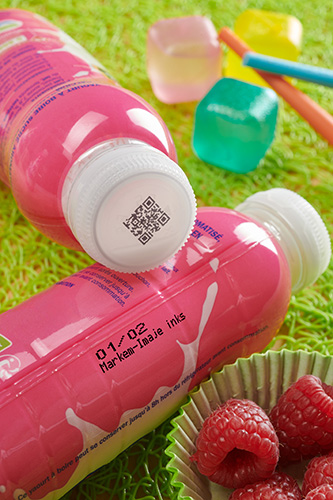2D barcodes offer brands a path to increase transparency, amplify engagement, and build efficient marketing through a seamless capture of data.
By Viktor Hermansson, Marketing Director, Markem-Imaje
Incremental advances to familiar technologies add up in the world of marketing. Social media, streaming services, and more recently AI have transformed brand engagement with consumers into ways that were unimaginable 20 years ago. However, these innovations have also fractured audiences and enabled the spread of disinformation. According to Accenture’s 2025 Life Trends report, 52% of respondents have seen fake news or articles, and 39% have seen fraudulent product reviews online. This complex and fast-changing digital world can make it hard even the best-intentioned brands to earn consumer trust.
Today, 2D barcodes offer a unique pathway for authentic communication between brands and consumers. Also known as QR codes, 2D barcodes store data horizontally and vertically, which expands capacity for information access compared to the standard UPC (1D) barcodes widely in use for point of sale (POS) handling and tracking product batch information. However, GS1 – a global organization for data compliance – has recently announced a standardized model for encoding important product details such as product and brand data as well as web URLs within a 2D barcode (GS1 Digital Link) that they encourage through their initiative, Sunrise 2027. This push for the widespread adoption of Digital Link technology stands to enable greater data and information accessibility and transparency across the value chain. For marketers, it also unlocks new opportunities for direct-to-consumer promotions and first party data collection to provide greater value.
A QR code on product packaging offers a window into a comprehensive, even customizable, brand experience. In brick-and-mortar stores, the Offline2Online idea is that consumers can scan the 2D barcode to access a wider range of product details at store shelves to increase conversion, engagement, and brand loyalty. This can include extensive information that just can’t be contained by the limited real estate of a physical package or label, including background on third-party certifications, suppliers, ingredient origins, sustainability measures, and ethical business practices. According to Edelman’s 2024 Trust Barometer Special Report: Brands and Politics, 84% of people globally report the need to share values with a brand to use it. Especially for younger consumers, this kind of information can influence purchase decisions at the retail location as nearly 6 in 10 Gen Z feel a connection with people who use the same brands that they do.
Online shoppers also stand to benefit from the use of Digital Link, especially if they can buy directly from the brand. At the scan of a single code, consumers can visit a product landing page that offers regular updates on special promotions, seasonal items, new drops, and pop-ups in their area. If brands host an e-commerce function, they can also renew purchases, schedule refills, and take advantage of available loyalty programs.
The way brands communicate in a crisis can make or break their relationships with consumers. Digital Link can also enable brands to implement a more comprehensive communications strategy in the event of a recall. In this scenario, companies typically issue press releases and updates over their branded social media accounts, relying heavily on news outlets to carry the information to consumers. Now, brands must also navigate the added complication posed by the media diet of younger generations, who often forego standard news sources in favor of content fed and filtered by algorithms. For these consumers, Digital Link offers a vital channel for expedient, direct, and controlled communication of important recall information and instructions for disposal or returns. Brands can leverage the linked platforms to let consumers know if their exact product is impacted, what they can do about it, offer refunds, and provide assurance by clarifying if their product is not impacted. While these scenarios are never ideal, swift action and transparency are important components to maintaining or regaining consumer trust.
Getting people to scan the 2D barcode can be a real challenge. Brands need to prompt consumers with exceptional experiences worth scanning for, where consumers are greeted with an engaging and interactive online experience. Accenture’s 2025 Life Trends report also identified what they call “impatience economy” – the belief that for many people, the pursuit of health, wealth, and happiness feels slow and tiresome, creating areas of life where people crave long-term support. In a fast-paced world, 68% of respondents said they would engage more with a brand that educates them through blogs and videos. The possibilities extend to entertainment, as well. More than ever, brands can extend their creative expression into original content and storytelling aligned with their values that incentivize more regular audience engagement.
Especially as AI-generated fakes stand to confuse consumers and counterfeit products threaten brand reputation, Digital Link also offers a channel for consumers to authenticate claims and validate the items they’ve purchased. Details on proper product use, maintenance, and disposal, as well as recyclability guidelines would be welcomed by consumers, aiding the brand by supporting a satisfying customer experience. 2D barcodes can also link to a feedback portal, allowing for two-way communication between brands and their consumers for a more supportive and personal experience. This tool is especially helpful when navigating GDPR or other data privacy laws to respect the privacy of consumers while inviting them to proactively share their feedback.

An overlooked benefit of 2D barcodes is the collection of data that can improve marketing performance and return on investment. By incentivizing consumers to scan QR codes, brands can gain access to their “cookies” and preferences, allowing them to learn more about their consumers and their buying behaviors. Through this process, it is critical for companies to adhere to local laws on privacy and data collection, ensuring practices are in line with regulations. Insights gathered through this data can shape marketing strategies and timing of special promotions and even tailor consumer communications based on location, reviews, and purchase history. The information influx can be leveraged to foster stronger, more loyal relationships with the brand by offering better recommendations and potentially perks such as rewards and discounts.
Internally, marketing analytics from data collection and analysis can point brands towards certain customer segments and consumer patterns that might encourage them to modify their strategy. Therefore, 2D barcodes continuously support internal and external business operations from decision-making within a company, to formulating decisions and communications with customers.
The benefits of implementing 2D barcodes throughout a business range from specific product tracking (batch number, serial number, best by date, production source) on the manufacturing and supply chain side, to gathering product and engagement data on the marketing side. They provide value to key stakeholders for the brand and retailer across the supply chain by maximizing data collection and opening the door to predictive analytics and business intelligence, as well as customized marketing efforts.
Incorporating 2D barcodes into business operations is not yet mandated by regulators, but brands that do not implement Digital Link technology in time could face compliance issues and loss in revenue in the future, as more retailers roll out 2D barcode mandates. While standard product packaging is bound with space and mode limitations, brands that implement 2D barcodes can unlock the full extent of this communication by taking the Offline2Online approach allowing for more imaginative and clever expression.
While 2D barcodes can bring great potential to business owners once fully integrated, the journey there is not without its obstacles. Brands need to work together with business partners they can trust to integrate the 2D technology and be able to scale with them as needed. GS1’s Sunrise 2027 project allows brands just enough time to seize the opportunities of 2D barcodes and rejoice in the benefits of data collection and interconnectivity.

About the Author:
Viktor Hermansson, Global Marketing & Communications Director at Markem-Imaje, brings over 20 years of B2B marketing experience from leading production automation companies. From hardware to software, Viktor has led perception change and driven the transition into Solution Providers.
In this episode, I sat down with Beejan Giga, Director | Partner and Caleb Emerson, Senior Results Manager at Carpedia International. We discussed the insights behind their recent Industry Today article, “Thinking Three Moves Ahead” and together we explored how manufacturers can plan more strategically, align with their suppliers, and build the operational discipline needed to support intentional, sustainable growth. It was a conversation packed with practical perspectives on navigating a fast-changing industry landscape.